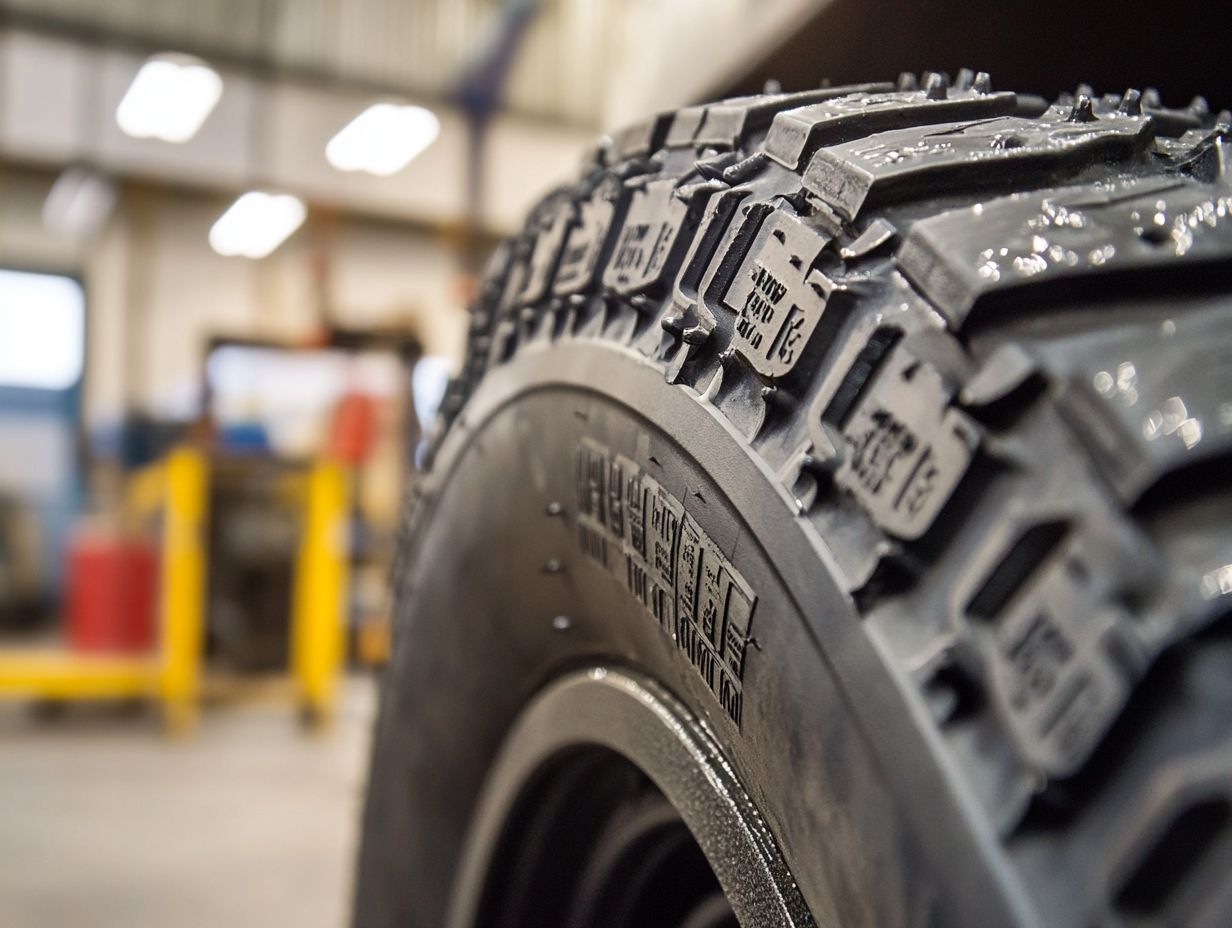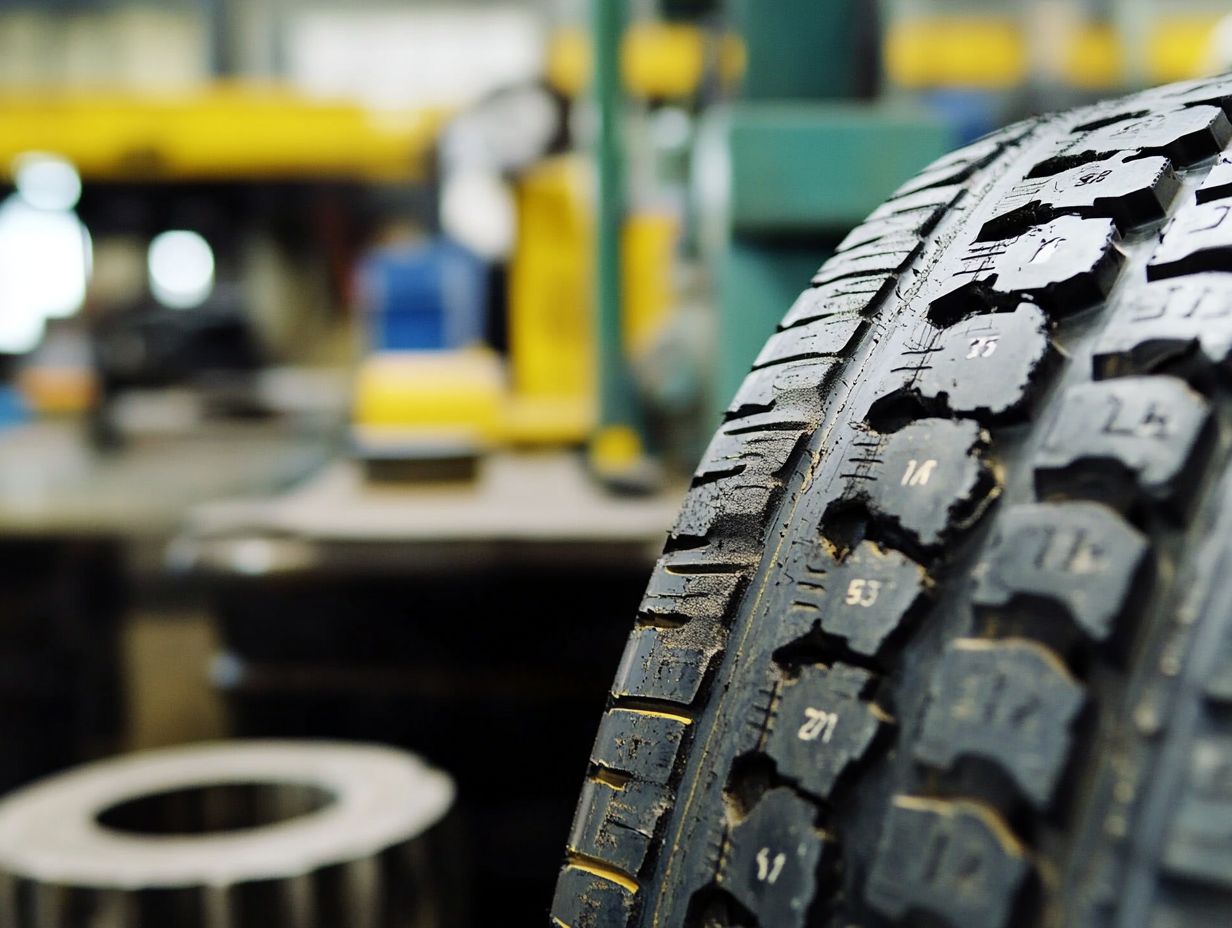How to Read Tire Sidewall Information?
Unlocking the secrets of tire sidewall information is key to keeping your vehicle safe and performing at its best. It offers vital details about your tires, including specifications, safety ratings, and maintenance tips.
This article explores the importance of reading tire sidewall information and guides you on interpreting the numbers and letters you ll encounter. We ll also clarify common terminology related to tire sidewalls.
Discover practical tips to maximize your tire performance and ensure safety on the road.
Contents
- Key Takeaways:
- Understanding Tire Sidewall Information
- Importance of Reading Tire Sidewall Information
- Interpreting Tire Sidewall Information
- Common Terminology on Tire Sidewalls
- Tips for Reading and Understanding Tire Sidewall Information
- Frequently Asked Questions
- What is tire sidewall information and why is it important?
- Where can I find the tire sidewall information?
- How do I read the tire sidewall information?
- What do the numbers and letters in the tire size section mean?
- What is the tire type section and what information does it provide?
- How can I use the tire sidewall information to choose the right tires for my vehicle?
Key Takeaways:

- Reading tire sidewall information is crucial for understanding your tires and ensuring proper maintenance.
- Tire sidewall information contains important details such as tire size, load index (the maximum weight a tire can safely carry), and speed rating that impact the performance and safety of your vehicle.
- When reading tire sidewall information, pay attention to the numbers and letters, as well as common terminology like treadwear rating and tire type, to make informed decisions about your tires.
Understanding Tire Sidewall Information
Understanding tire sidewall information is crucial for your vehicle’s safety and performance. This section holds key details like tire size, load index, speed rating, and more.
By examining the information on the tire’s sidewall, you equip yourself with the knowledge needed to make informed decisions regarding tire safety and compatibility, whether you re looking at passenger tires or light truck tires.
Carefully analyzing this data ensures your tires meet necessary specifications for optimal performance and safety on the road.
What is Tire Sidewall Information?
Tire sidewall information presents a wealth of markings that offer critical insights into the tire’s specifications and performance capabilities.
These markings reveal essential details such as tire size, load index, speed rating, and manufacturer information. Understanding this information is vital for selecting the right tires for various driving conditions, ensuring optimal safety on the road.
For example, the size marking provides insights into the width, aspect ratio, and construction type, while the load index indicates how much weight the tire can safely carry. The speed rating reveals the maximum speed the tire can handle.
By becoming familiar with these sidewall markings, you empower yourself to make informed choices that enhance both vehicle safety and performance.
Importance of Reading Tire Sidewall Information
Understanding tire sidewall information is essential for ensuring both safety and optimal performance. This crucial data reveals vital details such as load index, speed rating, and maximum load capacities.
Grasping these specifications allows you to select the right tires for your vehicle, boosting handling, fuel efficiency, and overall safety on the road. Ignoring these recommended specifications can lead to tire failure, compromised handling, and even accidents.
Therefore, every vehicle owner must familiarize themselves with the information on their tire’s sidewall.
Why is it Important to Know?

Knowing tire sidewall information is crucial not just for compliance but also for enhancing your vehicle’s safety and performance.
By understanding the details embedded in tire sidewalls, you significantly boost your vehicle’s load capacity, allowing for the safe and efficient transportation of goods and passengers. A solid grasp of aspect ratio management can lead to improved handling characteristics and overall ride quality, creating a smoother and more stable driving experience.
Armed with this knowledge, you can make crucial decisions that protect you and your loved ones on the road. Ultimately, prioritizing tire safety not only safeguards your vehicle and its occupants but also promotes the longevity and optimal functionality of your tires.
Interpreting Tire Sidewall Information
Interpreting tire sidewall information demands a clear understanding of key components, including load index, speed rating, and carcass construction (the layers that make up the tire). These elements offer valuable insights into the tire’s capabilities and limitations.
By deciphering these markings, you can make informed choices about your tire purchases, ensuring you select the right tires for specific driving conditions. Proper interpretation is vital for maintaining vehicle safety and performance, as each detail on the sidewall significantly impacts how the tire performs under various circumstances.
Breaking Down the Numbers and Letters
The numbers and letters on a tire s sidewall convey essential specifications, such as tire size, aspect ratio, DOT code, and rim diameter.
Understanding these components is vital for vehicle owners seeking to maintain optimal performance and safety. For instance, the tire size, often represented by a trio of digits, indicates the width in millimeters. The aspect ratio, shown as a two-digit number, reveals the height of the sidewall as a percentage of that width.
The DOT code, typically a mix of letters and numbers, holds crucial information about the tire s manufacturer and its production date, ensuring you’re informed about any product recalls. Lastly, the rim diameter indicates the size of the wheel that the tire will accommodate, guiding your selection for improved driving stability and efficiency.
Common Terminology on Tire Sidewalls
Having a solid grasp of the terminology found on tire sidewalls is essential for comprehending tire specifications. Key terms such as passenger tire, light truck tire, and radial construction play a crucial role in ensuring you make informed choices when selecting tires for your needs.
Definitions and Meanings

Key definitions like load index, speed rating, profile tire, and extra load are essential for accurately interpreting tire specifications.
Understanding the load index helps you determine how much weight each tire can safely support, ensuring your vehicle remains stable and secure under various conditions.
The speed rating, indicating the maximum speed a tire can handle, is crucial for performance-oriented drivers, as it directly impacts handling and safety on the road.
The profile tire, which compares the sidewall height to the width, significantly affects both ride comfort and handling characteristics.
If you often carry heavier loads, the concept of extra load becomes vital. Selecting tires designed for increased durability enhances safety and optimizes performance.
Grasping these key terms not only aids you in making informed tire choices but also elevates your overall driving safety.
Tips for Reading and Understanding Tire Sidewall Information
Follow these essential tips to boost your tire safety! It’s crucial to adhere to specific practices that enhance your understanding of maximum inflation and construction types. Embracing these best practices enables you to choose tires that fit perfectly and deliver optimal performance in various driving conditions.
By familiarizing yourself with tire specifications, you can significantly enhance your vehicle’s performance and extend the longevity of your tires, ultimately ensuring a safer and more enjoyable driving experience.
Guidelines and Best Practices
- Familiarize yourself with the various codes and symbols displayed on the sidewall.
- Recognize the importance of radial construction for better grip and stability.
- Understand the load index and speed rating for insights into your tire’s capabilities.
Mastering how to interpret these details will enable you to select the right tires, significantly reducing the risks associated with improper tire usage.
Frequently Asked Questions
Don’t miss out on understanding your tires! Check your tire sidewalls and ensure you understand each aspect to promote safety on the road.
What is tire sidewall information and why is it important?

Tire sidewall information refers to the series of numbers, letters, and symbols found on the side of a tire. It provides essential details about the tire’s size, type, and performance capabilities. This information is necessary for proper tire selection and maintenance.
Where can I find the tire sidewall information?
The tire sidewall information is typically located on the outer side of the tire, near the rim. You can find it on both the front and rear tires. It is usually imprinted in raised letters and numbers for easy identification.
How do I read the tire sidewall information?
The tire sidewall information is usually divided into three sections: tire size, tire type, and service description. Each section contains specific numbers and letters that indicate the tire’s measurements, construction, and capabilities.
Understanding each section is important to interpret the information correctly.
What do the numbers and letters in the tire size section mean?
The first set of numbers represents the tire’s width in millimeters. This is followed by the aspect ratio, which describes the height of the tire’s sidewall compared to its width as a percentage. The next letter indicates the tire’s construction, with “R” standing for radial, followed by the wheel diameter in inches.
For example, a tire sized 225/50R17 has a width of 225 millimeters, an aspect ratio of 50%, and fits on a 17-inch wheel.
What is the tire type section and what information does it provide?
The tire type section includes a combination of letters and numbers that indicate the tire’s specific type and performance characteristics. For example, “P” stands for passenger vehicle, “LT” stands for light truck, and “M+S” stands for mud and snow.
The numbers following these letters represent the tire’s speed and load ratings, indicating the maximum speed and weight the tire can handle.
How can I use the tire sidewall information to choose the right tires for my vehicle?
Understanding the tire sidewall information is crucial when choosing the right tires for your vehicle. By knowing the size, type, and capabilities of your tires, you can ensure they are compatible with your vehicle and meet your driving needs.
Make it a habit to check this information regularly for safety and performance!






